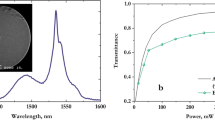Abstract
We demonstrate a passively mode-locked erbium-doped fiber laser (EDFL) by using the smallest single-walled carbon nanotubes (SWNTs) with a diameter of 0.3 nm as the saturable absorber. These ultrasmall SWNTs are fabricated in the elliptical nanochannels of a ZnAPO4-11 (AEL) single crystal. By placing an AEL crystal into an EDFL cavity pumped by a 980 nm laser diode, stable passive mode-locking is achieved for a threshold pump power of 280 mW and 73 ps pulses at 1563.2 nm with a repetition rate of 26.79 MHz.
Similar content being viewed by others
Mode-locked fiber lasers are of great interest for their wide applications in optical communication, material processing and biomedical diagnostics1,2,3. Compared to active mode-locking, passive mode-locking has the advantages of compactness, simplicity and flexibility. Passively mode-locked Er3+-doped fiber lasers have been widely investigated by using different kinds of saturable absorbers (SAs), such as semiconductor saturable absorber mirrors (SESAMs)4, graphene5 and gold nanocrystals6. In particular, single-walled carbon nanotubes (SWNTs) are outstanding SAs for their sub-picosecond recovery time, extremely high nonlinearities, wide operation range and low saturable intensity7,8,9. Normally, the SWNTs layers or SWNTs-polymer films are fabricated between fiber ferrule connectors to construct SWNTs-SAs10,11,12,13,14, which involve a heat-up risk for the SAs emit heat. In order to avoid the damage in high-power regime, the SWNTs are incorporated into a host material including nanoporous-alumina-membrane-hosting, glass-hosting and ceramics-hosting15,16,17.
Zeolite single crystal with uniform nanochannels is ideal template for fabricating of SWNTs. In our previous works, we reported 0.4 nm and 0.3 nm SWNTs accommodated in the nanochannels of AlPO4-5 and AlPO4-11 zeolite single crystals, respectively18,19,20,21. These small SWNTs show peculiar physical properties, which are not predicted in SWNTs with large diameter.
Here, we demonstrated a passively mode-locked EDFL by using 0.3 nm SWNTs as SAs. The broadband absorption of SWNTs@AEL single crystal enables fiber to mode-locking of EDFL at 1563.2 nm and 73 ps pulse with a repetition rate of 26.79 MHz.
An AlPO4-11 is of Ima2 space group symmetry; its framework consists of a one-dimensional 10-ring elliptical channel (inner diameter 0.65 nm × 0.4 nm) which is an ideal template for synthesizing 0.3 nm SWNTs. However, the density and quality of the 0.3 nm SWNTs in the AlPO4-11 matrix is low for its inert framework. To tackle this problem, Zn cations are incorporated into the framework of AlPO4-11. Figure 1(a) shows a typical scanning electron microscope image of the ZnAPO4-11 (AEL) single crystals. The SWNTs were synthesized by pyrolyzing dipropylamine carbon precursor molecules in the AEL nanochannels. The carbon precursor containing AEL single crystals were dehydrated at 383 K in a vacuum of 10−3 mbar for 2 h and then gradually heated up to 773 K for 5 h. Figure 1(b) shows an armchair (2,2) carbon nanotube, which is sketched inside of 10-ring channel of AEL. In Fig. 1(c), we show the Raman spectrum of a SWNT@AEL single crystal measured using the 514.5-nm line of an Ar-Kr ion laser as the excitation. All Raman spectra were measured under a backscattering configuration using a micro-Raman system (JobinYvonT64000). In general, the Raman spectra exhibits two main features: (1) there exists a strong characteristic radial-breathing mode (RBM) at 760 cm−1 together with some weak features of vibration modes in the low-frequency region (300–1100 cm−1); (2) The tangential graphite-like G band that is splitted into G+ modes in the high frequency region (1550–1620 cm−1) and G− modes in the intermediate frequency region (1110–1500 cm−1)19. It is obvious to note that the relative ratio of the RBM to G-band (IRBM/IG) exhibits a sharp increase in comparison to our previous work, which implies higher quality of carbon nanotubes. The absorbance spectrum of the SWNTs@AEL single crystal is shown in Fig. 1(d): it has a broadband centered at 1486 nm, with peak absorbance of about 0.51.
The as-obtained SWNTs@AEL single crystal was placed between two fiber connectors to form a fiber-compatible SA and then integrated into a laser cavity, as show in Fig. 2. A 980 nm laser diode (LD) was used as the pump source. The pump light was launched into the laser cavity through a 980/1550 nm wavelength-division multiplexing (WDM) coupler. A 1.5-m-long erbium-doped single-mode silica fiber was used as the gain medium. An optical isolator (ISO) was used to force the unidirectional operation. The polarization controller (PC) was utilized for optimization of the laser output. The total cavity length is about 5.6 m. The SA was inserted into the laser cavity to induce mode-locking operation. A fused 5/95 output couple was utilized. The 5% port extracted the pulses from the cavity. The output lasers were analyzed by using an optical spectrum analyzer (OSA) and a 20 GHz high-speed oscilloscope (Tektronix MSO 72004C) together with a 45 GHz photo-detector (New Focus 1014).
With increasing the pump power to 240 mW, continuous wave (CW) laser operation started. Stable mode-locked pulse laser oscillation was obtained as soon as the pump power exceeded the threshold of 280 mW. Figure 3(a) shows the output pulse trains of mode-locked EDFL by using a digital oscilloscope. The repetition rate is 26.79 MHz (period τ = 37.33 ns), as determined by the cavity length. Figure 3(b) shows the a single pulse profile of the above mode-locked fiber laser and the measured pulse width is about 73 ps. Figure 3(c) shows the radio frequency (RF) power spectrum of the laser output after optical-to-electrical conversion using a fast photodiode. A 62 dB peak-to-background ration is observed for the fundamental peak at resolution of 1 kHz. This result indicates good mode-locking stability. Figure 4(a) shows the emission spectrum of above mode-locked laser by using an OSA with spectrum resolution of 0.05 nm. The spectrum with two Kelly bands shows a typical feature of soliton mode-locking lasers22. The operating center wavelength is about 1563.2 nm and the spectral width at half-maximum is about 3 nm. In order to verify the effects of the SWNTs on mode-locking, we placed a bare AEL crystal in the cavity. As we can see from Fig. 4(b), only continuous wave (CW) laser operation with a wavelength at 1562.6 nm was observed, which confirmed that the above mode-locked EDFL was induced by 0.3 nm SWNTs.
In conclusion, 0.3 nm SWNTs hosted in AEL single crystal were used as SA to build all-fiber mode-locked fiber lasers. When the SA was used in an EDFL, stable passively mode-locking was achieved with a threshold pump power of 280 mW and 73 ps pulses at 1563.2 nm with a repetition rate of 26.79 MHz. Our results show that the SWNTs hosted in zeolite single crystal is one promising SA for mode-locked fiber lasers in high-power operation.
References
Keller, U. Recent developments in compact ultrafast lasers. Nature 424, 831–838 (2003).
Okhotnikov, O., Grudinin, A. & Pessa, M. Ultra-fast fibre laser systems based on SESAM technology: new horizons and applications. New J. Phys. 6, 177 (2004).
Wise, F. W., Chong, A. & Renninger, W. H. High-energy femtosecond fiber lasers based on pulse propagation at normal dispersion. Laser Photonics Rev. 2, 58–73 (2008).
Ouyang, C. et al. Bidirectional passively mode-locked soliton fiber laser with a four-port circulator. Opt. Lett. 36, 2089–2091 (2011).
Sun, Z. et al. Graphene Mode-Locked Ultrafast Laser. ACS Nano 4, 803–810 (2010).
Kang, Z. et al. Passively mode-locking induced by gold nanorods in erbium-doped fiber lasers. Appl. Phys. Lett. 103, 041105 (2013).
Set, S. Y., Yaguchi, H., Tanaka, Y. & Jablonski, M. Ultrafast fiber pulsed lasers incorporating carbon nanotubes. IEEE J. Sel. Top. Quantum Electron. 10, 137–146 (2004).
Song, Y. W., Yamashita, S., Goh, C. S. & Set, S. Y. Passively mode-locked lasers with 17.2-GHz fundamental-mode repetition rate pulsed by carbon nanotubes. Opt. Lett. 32, 430–432 (2007).
Valle, G. D. et al. Passive mode locking by carbon nanotubes in a femtosecond laser written waveguide laser. Appl. Phys. Lett. 89, 231115 (2006).
Yamashita, S. et al. Saturable absorbers incorporating carbon nanotubes directly synthesized onto substrates and fibers and their application to mode-locked fiber lasers. Opt. Lett. 29, 1581–1583 (2004).
Hasan, T. et al. Nanotube–Polymer Composites for Ultrafast Photonics. Adv. Mater. 21, 3874–3899 (2009).
Fong, K. H. et al. Solid-state Er:Yb:glass laser mode-locked by using single-wall carbon nanotube thin film. Opt. Lett. 32, 38–40 (2007).
Popa, D. et al. 74-fs nanotube-mode-locked fiber laser. Appl. Phys. Lett. 101, 153107 (2012).
Wang, F. et al. Wideband-tuneable, nanotube mode-locked, fibre laser. Nat. nanotechnology. 3, 738–742 (2008).
Kurashima, Y., Yokota, Y., Miyamoto, I., Kataura, H. & Sakakibara, Y. Mode-locking nanoporous alumina membrane embedded with carbon nanotube saturable absorber. Appl. Phys. Lett. 94, 223102 (2009).
Kim, H. J., Choi, H. J., Nam, S. M. & Song, Y. W. High-performance laser mode-locker with glass-hosted SWNTs realized by room-temperature aerosol deposition. Opt. Express 19, 4762–4767 (2011).
Song, Y. W. Q-switched fiber lasers with carbon nanotubes hosted in ceramics. Appl. Optics 51, 290–294 (2012).
Tang, Z. K. et al. Superconductivity in 4 angstrom single-walled carbon nanotubes. Science 292, 2462–2465 (2001).
Tang, Z. K. et al. Resonant Raman Scattering of the Smallest Single-Walled Carbon Nanotubes. Phys. Rev. Lett. 101, 047402 (2008).
Mei, Y. F. et al. Visible cathodoluminescence of 4 Å single-walled carbon nanotubes. Appl. Phys. Lett. 87, 213114 (2005).
Guo, J. D. et al. Efficient Visible Photoluminescence from Carbon Nanotubes in Zeolite Templates. Phys. Rev. Lett. 93, 017402 (2004).
Kartner, F. X., Jung, I. D. & Keller, U. Soliton Mode-Locking with Saturable Absorbers. IEEE J. Sel. Top. Quantum Electron. 2, 540–556 (1996).
Acknowledgements
This research was supported by National Natural Science Foundation of China (No. 61275144) and Shenzhen Science and Technology Project (No. JCYJ20130329142000199 and JCYJ20130329141827934).
Author information
Authors and Affiliations
Contributions
S.C.R. proposed and directed the project. X.T.X. carried out the experiment. X.T.X., J.P.Z., L.L., Y.P.C., Y.Q.Y., M.Z., S.C.R. and Z.K.T. all discussed the results, commented on and revised the manuscript.
Ethics declarations
Competing interests
The authors declare no competing financial interests.
Rights and permissions
This work is licensed under a Creative Commons Attribution-NonCommercial-ShareAlike 4.0 International License. The images or other third party material in this article are included in the article's Creative Commons license, unless indicated otherwise in the credit line; if the material is not included under the Creative Commons license, users will need to obtain permission from the license holder in order to reproduce the material. To view a copy of this license, visit http://creativecommons.org/licenses/by-nc-sa/4.0/
About this article
Cite this article
Xu, X., Zhai, J., Li, L. et al. Passively mode-locking erbium-doped fiber lasers with 0.3 nm Single-Walled Carbon Nanotubes. Sci Rep 4, 6761 (2014). https://doi.org/10.1038/srep06761
Received:
Accepted:
Published:
DOI: https://doi.org/10.1038/srep06761
This article is cited by
-
8-HQCdCl2H2O as an organic Q-switcher in erbium laser cavity
Optoelectronics Letters (2023)
-
Generation of Picosecond Pulses in Erbium-Doped Fiber Lasers Via Mode Locking Using V4AlC3 Thin Film
Journal of Russian Laser Research (2023)
-
Dual-wavelength Q-switched erbium-doped fiber laser using an SMF-MMF-SMF structure and graphene oxide
Optoelectronics Letters (2022)
-
Ti3AlC2 coated D-shaped fiber saturable absorber for Q-switched pulse generation
Optoelectronics Letters (2022)
-
Flexible pulse-controlled fiber laser
Scientific Reports (2015)
Comments
By submitting a comment you agree to abide by our Terms and Community Guidelines. If you find something abusive or that does not comply with our terms or guidelines please flag it as inappropriate.







